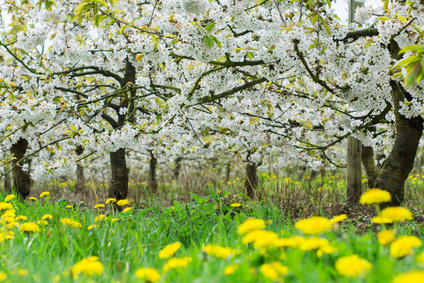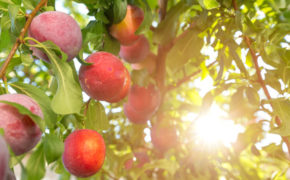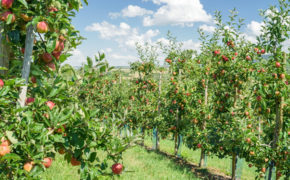
Get a quick no obligation quote It’s free and will only take a jiffy!
Wild Cherry Tree
Everything you need to know about the wild cherry tree, from identification tips to typical characteristics; wild cherry mythology and value to the environment; how to identify disease and the best methods of cherry tree care.
There are many types of cherry tree; all of them part of the same family that produces peaches, plums and apricots. Some cherry trees are native to the UK, others are not so but nonetheless prevalent in this country. Here we are looking specifically at the wild cherry, a UK native species.
General Facts
| Known as | Wild cherry, gean (Scotland) |
| Latin name | Prunus avium |
| Location | UK and all of Europe except the far north |
| Foliage | Deciduous |
| Lifespan | Up to 60 years |
Characteristics
| Height | Up to 30 metres |
| Spread | More than 8 metres |
| Appearance | Deep reddish/purple-brown smooth, shiny bark with noticeable cream/grey coloured horizontal lines. Very attractive and ornamental in appearance, often with eye-catching trailing branches that sprawl wide from the trunk and a cascade style. In the winter the twigs can be identified by oval shaped clustered buds. |
| Leaves | Green in colour and oval in shape; toothed with pointed tips and slightly straight lines that look like veins running through. Measure between 6 and 15cm and bear two notable red glands on the stalk at the base of the leaf. Transform through green in spring then orange through to deep crimson in the autumn. |
| Flowers | White, cup-shaped flowers appear in April, each bearing five petals and measuring between 8 and 15mm in width and hanging in clusters of 2-6. |
| Fruit | Once pollinated by insects the flowers develop into smooth fruits starting yellowy-red then fully ripening to a deeper reddish purple. The fruits bear a single stone. |
| Found in | Gardens |
Conditions
| Ideal soil | Wild cherry trees prefer moist but well-drained fertile sand, clay, chalk or loam soil |
| Soil pH | Alkaline, neutral, acid |
| Aspect | South, north, east or west facing |
| Exposure | Full sun |
Threats
| Pests | Aphids, caterpillars, leaf-mining moths, bullfinches, cherry blackfly |
| Diseases | Silver leaf disease, bacterial canker, blossom wilt |
Wild Cherry Tree Fruits
Wild cherry trees produce both male and female flowers, so you’ll only need to have one in your garden to produce fruit.
The fruits of the wild cherry tree start to appear once the April blossom has subsided. At first they appear yellowy-red and then gradually transform as they ripen to dark red-purple by July. The fruits of the wild cherry tree tend to have a more tart or bitter taste than some of the sweeter varieties and are less fleshy.
If you are keen to harvest your wild cherry crop for yourself then you’ll have a battle against the birds that will probably have had their beady eyes on the developing fruits for some time, so you may wish to consider protecting your tree with a net where possible – or just be quick! The second part of the botanical name of the wild cherry, ‘avium’, means ‘birds’, so now you know how it got its name.
Wild cherries, being tarter in flavour, make excellent pies and jams.
Wild Cherry Trees and Wildlife
The spring flowers of the wild cherry tree offer a font of pollen and nectar for bees. The cherries themselves are favourite fodder for the song thrush and blackbird and are also much loved by the dormouse, the wood mouse, the yellow necked mouse and the badger.
Caterpillars of various moth species tend to indulge on the leaves. These include the short cloaked moth, the brimstone moth, the orchard ermine moth and the cherry fruit and cherry bark moths.
Wild Cherry Tree Symbolism
The wild cherry is thought to have had enigmatic qualities according to Highland folklore and in those days to come across a wild cherry tree was considered fortunate.
Wild cherry folklore is also associated with the cuckoo. It was said that this bird cannot stop singing until it has eaten three good meals of cherries. In Scotland, the wild cherry is known as ‘gean’. This is thought to have been derived from ‘guigne’, a French word for cherry.
Years ago the resin that leaks from the trunk was recorded as a cough treatment and was often dissolved in wine to treat gall stones and kidney stones.
The Importance of Wild Cherry Trees
If you can beat the birds, the wild cherry tree will provide a delicious crop of fruit which can be eaten naturally or made into pies or used to flavour alcoholic drinks such as brandy, gin and whisky.
Cherry tree wood is very important in furniture making. With its hard, robust and fine-grained composition and prominent, characterful burls it is ideal for this purpose and will often be used in the crafting of high-end cabinetry and decorative veneers thanks to its deep brown hue which polishes to a brilliant shine.
Wild cherry trees are very attractive, particularly when blossoming, and the Woodland Trust recommends they make a wonderful addition to any wildlife garden, providing space is not at a premium due to the potential height and span.
Caring for a Wild Cherry Tree
Wild cherry trees call for expert pruning to encourage a strong branch structure in order to support the heavy fruit crops. Pruning will also allow for improved airflow which will enhance the quality of the fruit. It also makes harvesting easier and helps to thwart disease.
With cherry tree pruning, the objective is to promote an open and well balanced branch structure. Get it right at an early age and the tree will enjoy a good form that allows for healthy fruit yields and overall good health.
It is very important to prune a wild cherry tree at the right time of year, and in the correct way. Failure to do so could result in damage to the tree. There is also a host of diseases and pests to look out for. Read more about cherry tree pruning and care.
The best possible advice is to engage the services of a qualified tree surgeon to assist you in taking care of your wild cherry tree. That way you can feel reassured that it will thrive for many years to come, producing healthy and abundant crops of fruit and providing excellent aesthetic pleasure.
If you have a wild cherry tree on your land that needs expert tree care, why not talk to T.H. Tree Services? As fully qualified and highly experienced tree surgeons, we are able to offer exceptional knowledge on all aspects of wild cherry tree care. For a free, no-obligation quotation, give us a call on 01268 642814 or get in touch here.
I can thoroughly recommend TH Trees. Their professionalism and communication has always been paramount. The jobs undertaken carried out to my satisfaction. Above and beyond.
Thank you Jo for your kind review, it's always a pleasure to be of assistance with your trees.








